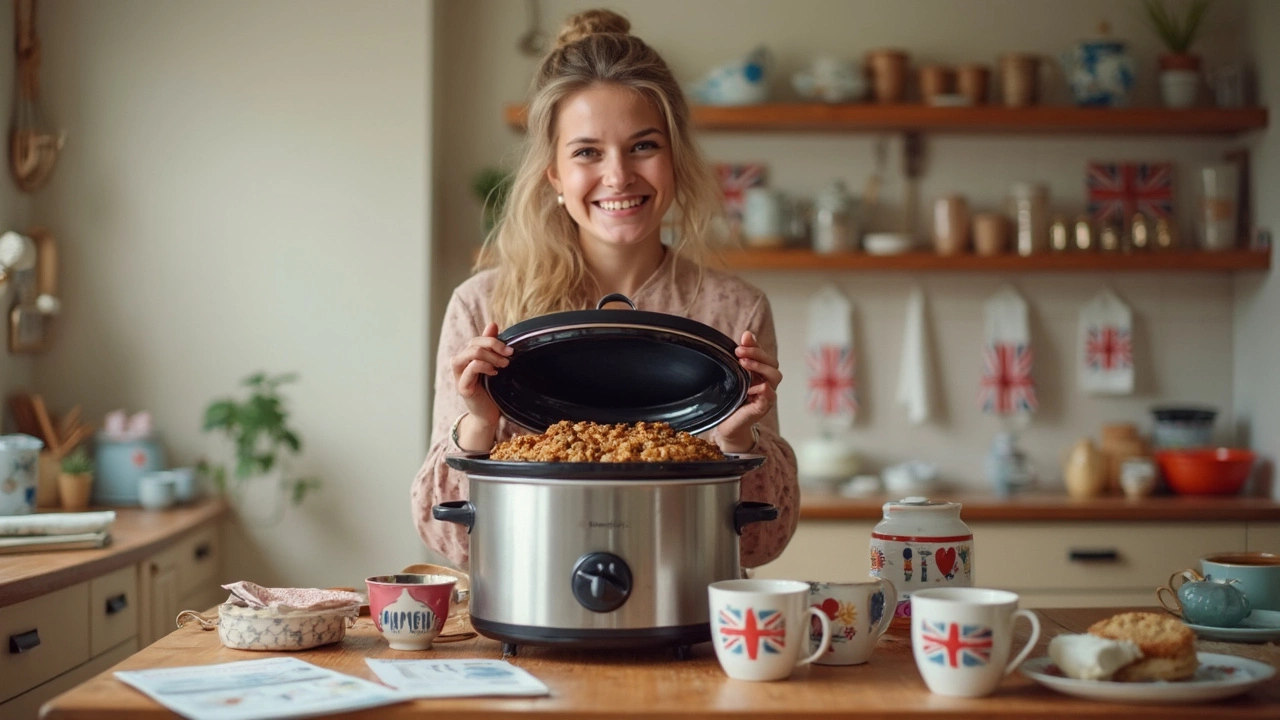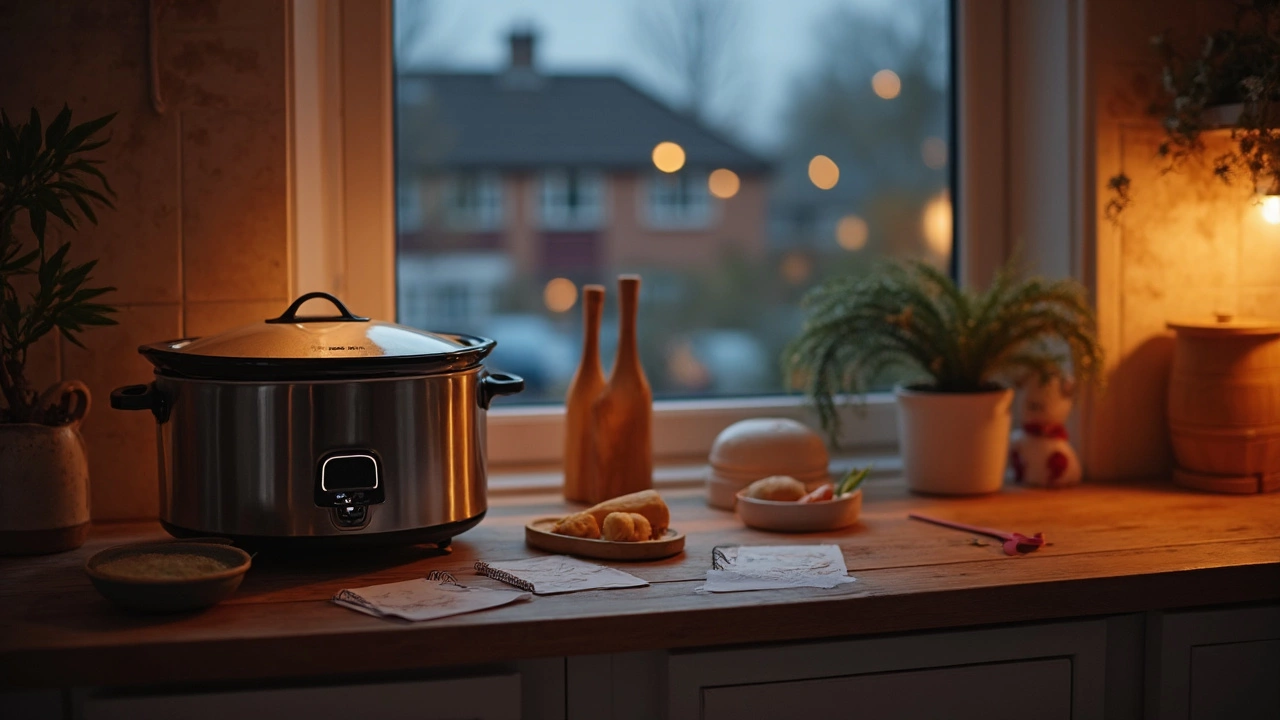You’re thinking about throwing dinner in the slow cooker before bed and letting it simmer while you sleep. It sounds convenient, but also a little risky, right? The last thing anyone wants is waking up to a smoky kitchen, ruined meal, or worse.
Slow cookers are basically designed for low-and-slow jobs, and most modern ones come with tons of safety features. Still, not every slow cooker acts the same, and you need to play by the rules to keep things safe — and tasty.
Ever notice how pulled pork or chili somehow tastes better after bubbling away for hours overnight? That magic comes from letting flavors really develop. But there are some tricks you need to know if you want that tender perfection without any late-night disasters.
If you’re unsure about leaving your slow cooker on all night, keep reading. We’ll break down what’s safe, what’s not, and give you real steps to make sure you wake up to a delicious, worry-free meal.
- Why People Use a Slow Cooker Overnight
- Is It Really Safe to Leave It On?
- How to Make It Work Without Worry
- Common Problems and Easy Fixes
- Smart Tips for Better Overnight Results
Why People Use a Slow Cooker Overnight
Most people run their slow cooker overnight for one big reason: time. You can prep your meal before bed, set it up, and sleep while dinner—or lunch for the next day—cooks itself. It’s a total game changer for folks with packed schedules or parents juggling a million things. When morning comes, you’re greeted with food that usually tastes like you spent hours standing by the stove.
Certain dishes really benefit from that long, slow cook. Think of big cuts of meat—like pork shoulder or beef brisket—that need hours to break down and get juicy. Dried beans, stews, and chili seriously level up after cooking all night. If you work a standard 9 to 5, the slow cooker lets you skip the rush. Toss everything in before bed, and by lunchtime, you’ve got something hot and hearty. Some people even use overnight slow cooking for breakfast—steel-cut oats made this way turn out extra creamy, way better than packets in the microwave.
Here’s why overnight slow cooking wins people over:
- Saves precious time in the evenings and mornings
- Makes tough cuts of meat tender without babysitting
- Perfect for batch cooking—leaving leftovers for the whole week
- Great for meal prep if you want lunches ready to grab and go
- Keeps the kitchen cooler, especially in the summer
Letting your slow cooker do its thing overnight isn’t just about convenience. It’s built for the job. Most modern models come with timers, auto-warm settings, and better temperature control than older ones. That’s what gives people confidence to actually press start before heading to bed. When done right, overnight slow cooking fits into even the busiest lifestyles, with almost zero hassle.
Is It Really Safe to Leave It On?
Let’s get straight to it: most modern slow cookers are engineered to run for hours—even overnight—without a hitch. They run on a low wattage (usually 70-250 watts on "low") and maintain a stable, consistent temperature well below boiling, but high enough to keep food out of the danger zone where bacteria grow. If you’re using a slow cooker made after 2010 and it’s in good shape, leaving it on while you sleep is genuinely considered safe by both manufacturers and food safety experts.
The real risk is not electrical fire—those are extremely rare with slow cookers. According to the slow cooker manufacturers Crock-Pot and Hamilton Beach, incidents of slow cooker fires are less than 1 per 10 million units per year. That’s lower than your chance of your toaster acting up or your phone charger overheating. Check out this quick comparison:
| Appliance | Annual Fire Incidents (US) |
|---|---|
| Slow Cooker | 50 - 100 |
| Microwave | 1,000+ |
| Toaster | 800+ |
Food safety matters, though. The USDA says you should keep food above 140°F (60°C) to prevent nasty bacteria like salmonella from growing. If your slow cooker is at least half-full (liquid helps conduct heat), with the lid on, and you stick to the "low" or "warm" settings, you’re in the safe zone.
Still, not every slow cooker is a hero. Avoid old, worn-out units, or anything with a cracked ceramic insert or fraying cords. If your cooker looks sketchy, skip leaving it on overnight. Also, place it on a flat, heat-safe surface—no dish towels or paper underneath. This isn’t the time for shortcuts.
Bottom line: following the manufacturer’s instructions and some common sense, leaving your slow cooker on low overnight is about as risky as, well, leaving the porch light on. That’s what keeps slow cookers a weeknight lifesaver for busy folks everywhere.

How to Make It Work Without Worry
No one wants a trip to the grocery store at sunrise just because a slow cooker meal turned into a mess, or worse, a safety hazard. Here’s how you can confidently let your slow cooker do the heavy lifting while you get your sleep.
First rule: always read your slow cooker’s manual. Nearly all big brands design their cookers for unattended use. According to Crock-Pot’s official FAQ, leaving your slow cooker on for 8-10 hours on low is totally safe for their latest models, assuming you’re not using a damaged cord or old unit.
- slow cooker placement matters. Keep it on a flat, heat-resistant surface. No towels, no stacks of cookbooks—just a clear countertop, at least a few inches away from the wall or any items that could melt.
- Double-check your outlet. Slow cookers do best on their own outlet, no power strips or extension cords. This helps prevent electrical issues.
- Don’t overfill. The sweet spot is between half and three-quarters full. Overfilling leads to spills, under-filling means your food could dry out or even burn. Sunbeam published a test in 2022 showing that a crock filled below halfway can reach too-high temps, which affects safety and flavor.
- Only use the lid that comes with your cooker, and keep it sealed. Lifting the lid drops temperatures fast—by about 10-15°F each time. You want steady heat all night.
- Set it to low if you’re running overnight. "Warm" mode is only for keeping food at a safe temp (above 140°F) after it’s cooked, not for actual cooking.
| Hour | Slow Cooker (Low) Avg Temp | Safe Minimum Food Temp |
|---|---|---|
| 2 | 155°F | 140°F |
| 4 | 175°F | 140°F |
| 8 | 180°F | 140°F |
The U.S. Department of Agriculture (USDA) says bacteria are killed above 140°F. Most modern slow cookers on "low" keep food between 170-200°F, so you’re in the safe zone. But if your slow cooker is from the 1980s, upgrade—it may not reach safe temps.
If you work early or worry about timing, find a slow cooker with a built-in timer. That way, it’ll switch to "warm" and hold your food at a safe-temp until you wake up. Most new digital models offer this handy feature.
Want stress-free mornings? Prep your ingredients the night before, throw them in the fridge, and set everything up fast before bed. If you start with cold ingredients, allow some extra time for your slow cooker to hit safe temperatures. That’s the only workaround that takes a little planning.
Common Problems and Easy Fixes
A lot of folks run into issues the first time they leave their slow cooker running overnight. The main complaints? Food either turns to mush, dries out, or ends up kinda bland. These problems usually pop up because slow cookers aren’t all the same, and different recipes need different tricks.
- Food gets too dry: If you forget to add enough liquid, things like roasts or chicken breasts can basically shrivel up by morning. Double-check your recipe’s liquid-to-solid ratio. As a rule, you want at least a cup or two of broth or water for most dishes. If you’re leaving your slow cooker on low overnight, a bit more liquid than usual is safer.
- Veggies turn to mush: Carrots and potatoes are famous for going soft and soggy after 8 hours. To avoid this, cut them into bigger chunks. If you really want your veggies to have some bite, add them halfway through the cook if you’re able to do a mid-night check, or put root veggies under your meat so they cook slower.
- Food tastes bland: That extra-long cooking time can flatten flavors, especially if you dump in delicate herbs at the start. Instead, add greens, fresh herbs, or citrus at the end, once you wake up and switch the cooker off.
- Bacteria worries: This gets brought up all the time. The good news—if your slow cooker is set to low, it should keep food at about 170-200°F (76-93°C), which is safely above the danger zone for bacteria (40-140°F or 4-60°C). But to be extra sure, don’t use frozen meat straight from the freezer, as it takes too long to reach safe temps. Thaw it first.
- Overflows and splatters: Filling your slow cooker right to the top is asking for a mess in the morning. Stick to about two-thirds full. Wipe down the rim before starting so the lid seals properly and no steam escapes.
Most of these issues boil down to three things: enough liquid, not overcrowding, and careful ingredient timing. Get those right, and your slow cooker is all but set for an overnight win.

Smart Tips for Better Overnight Results
Want your food to taste great and your kitchen to stay safe while your slow cooker runs overnight? Here’s how to do it right. These straightforward tips will help you wake up to perfectly cooked meals—not a mess or disappointment.
- Use the right size slow cooker: A good rule is to fill it between half and two-thirds full. Too empty, and it could cook too fast or burn. Too full, and it might bubble over or not cook through.
- Prep ingredients smartly: Cut veggies the same size so they cook evenly. Brown meat before adding (if you’ve got a minute)—it really boosts flavor and texture, especially for roasts or stews.
- Layer with care: Put hard veggies like carrots and potatoes at the bottom. They take longer to cook, so they need the most heat. Add meat and softer stuff on top.
- Go easy on dairy and delicate greens: Add milk, cheese, cream, or spinach last—either in the morning or in the last hour—so they don’t separate or turn mushy.
- Don’t keep peeking: Every time you lift the lid, you lose heat and add about 20 extra minutes to the cook time. Trust the process—unless it smells like something’s burning.
If your slow cooker has a timer, use it. Set it to switch to ‘keep warm’ after the recipe’s done, so your food doesn’t dry out or get overcooked if you sleep in.
Prepping an overnight meal for the first time? Try a safe bet, like pulled pork or a bean chili. These are forgiving, won’t overcook easily, and are still tasty after 8+ hours on low.
Worried about bacteria? The USDA recommends that food stays above 140°F after cooking to keep things safe. Here’s a quick look at common slow cooker temps based on actual manufacturer specs:
| Setting | Typical Temp (°F) | Purpose |
|---|---|---|
| Low | 190-200 | Long, overnight cook |
| High | 240-250 | Quick cooks, not for overnight |
| Keep Warm | 165-185 | Hold after cooking, food-safe zone |
Finally, always check your appliance manual. Every slow cooker is a bit different, and using yours the right way keeps everything ticking trouble-free. A little prep, some smart testing, and you’re set for years of hassle-free overnight cooking.

